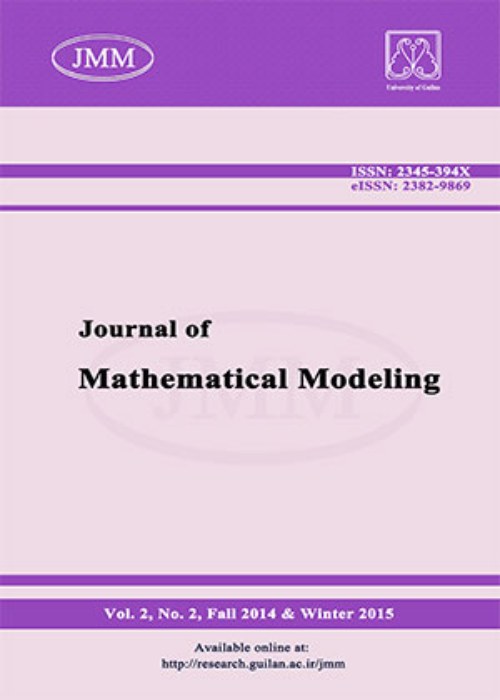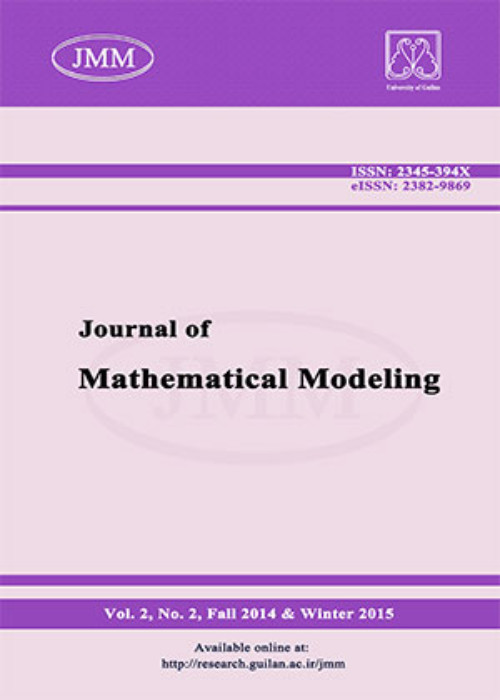فهرست مطالب

Journal of Mathematical Modeling
Volume:11 Issue: 4, Autumn 2023
- تاریخ انتشار: 1402/09/27
- تعداد عناوین: 12
-
-
Pages 605-616This article aims at proposing and developing a three-component mathematical model for susceptible, infected and recovered $(SIR)$ population, under the control of vaccination of the susceptible population and drug therapy (antivirus) of the infected population (patient) in case of an infectious disease. The infectious disease under study can be transmitted through direct contact with an infected person (horizontal transmission) and from parent to child (vertical transmission). We investigate the basic reproduction number of the mathematical model, the existence and local asymptotic stability of both the disease free and endemic equilibrium. Using Pontryagin's minimum principle, we investigate the conditions of reducing the susceptible and infected population and increasing the recovered population based on the use of these two controllers in society. A numerical simulation of the optimal control problem shows, using both controllers is much more effective and leads to a rapid increase in the recovered population and prevents the disease from spreading and becoming an epidemic inthe society.Keywords: optimal control, infectious diseases, basic reproduction number, Stability, Mathematical model
-
Pages 617-630The unsteady Helmholtz type equation of anisotropic functionally graded materials (FGMs) is considered in this study. The study is to find numerical solutions to initial boundary value problems governed by the equation. A combined Laplace and boundary element method is used to solve the problems. The analysis derives a boundary-only integral equation that is used to compute the numerical solutions. The analysis also results in another class of anisotropic FGMs of applications. Some problems are considered. The numerical solutions obtained are accurate and consistent.Keywords: Anisotropic, FGMs, unsteady state, Helmholtz equation, boundary element method
-
Pages 631-647We propose an algorithm that estimates the real roots of differentiable functions on closed intervals. Then, we extend this algorithm to real differentiable functions that are dominated by a polynomial. For each starting point, our method converges to the nearest root to the right or left hand side of that point. Our algorithm can look for missed roots as well and theoretically it misses no root. Furthermore, we do not find the roots by randomly chosen initial guesses. The iterated sequences in our algorithms converge linearly. Therefore, the rate of convergence can be accelerated considerably to make it comparable to Newton-Raphson and other high-speed methods. We have illustrated our algorithms with some concrete examples. Finally, the pseudo-codes of the related algorithms are presented at the end of this manuscript.Keywords: Krasnoselskii sequence, iterative Method, Newton-Raphson method, root estimation, real function
-
Pages 649-663This article considers a particular type of fuzzy multi-choice linear programming (FMCLP) model in which there are several choices for the fuzzy parameters on the right-hand side (RHS) of problem constraints. We first construct the fuzzy polynomials to solve this model using the fuzzy multi-choice parameters on the RHS of constraints. We construct the fuzzy polynomials by approximating fuzzy functions, including the binary variable approach, Lagrange, and Newton's interpolating polynomials. Also, we use the least squares approach to construct the approximating fuzzy polynomial. Then we solve the resulting model. Finally, we will examine the above techniques in numerical examples.Keywords: Fuzzy multi-choice linear programming model, fuzzy binary variable approach, fuzzy interpolation polynomials, fuzzy least squares method
-
Designing and evaluating an optimal budget plan for parallel network systems through DEA methodologyPages 665-680For an optimal system design (OSD), data envelopment analysis (DEA) treats companies as black boxes disregarding their internal processes. Considering the effect of these processes into account companies can upgrade their internal mechanisms of optimal budgeting allocation. The internal processes can be defined as series and parallel networks or a combination of them. In the literature, DEA is utilized as an approach for OSD in order to determine the optimal budget for a company's activities in a system of series network production; but it is shown that this model is not suitable for budgeting parallel systems. To fill this gap, a new model is presented in this paper to evaluate a company's optimal budgeting which has a parallel network system. The presented parallel network OSD via DEA models, allocates the optimal budget to each of the internal processes of the decision-making units (DMU) based on the efficiency of the parallel internal processes. The model, with a limited budget, also is able to identify the amount of budget deficit and congestion. In this regard, two real cases are studied using the suggested model, which is presented in the parallel network OSD via DEA and Forest production in Taiwan. The optimal budget, budget deficit and congestion, and also the advantages of the proposed model are discussed in these examples as well.Keywords: Network data envelopment analysis, budgeting, parallel system, DEA
-
Pages 681-693We consider a new class of square Fibonacci $(q+1)\times(q+1)$-matrices in public key cryptography. This extends previous cryptography using generalized Fibonacci matrices. For a given integer $q$, a $(q+1)\times(q+1)$ binary matrix $M_{q}$ is a matrix which nonzero entries are located either on the super diagonal or on the last row of the matrix. In this article, we have proposed a modified public key cryptography using such matrices as key in Hill cipher and key agreement for encryption-decryption of terms of $M_{q}$-matrix. In this scheme, instead of exchanging the whole key matrix, only a pair of numbers needed to be exchanged, which reduces the time complexity as well as the space complexity of the transmission and has a large key space.Keywords: Cryptography, Hill cipher, key exchange Elgamal, Fibonacci sequence, $M, {q}$-matrix
-
Pages 695-708This paper proposes a new robust optimization approach for solving multi-objective linear programming problems under uncertainty. The uncertainty is assumed to be in the objective function coefficients and the constraint parameters. The proposed approach is based on an alternative model for obtaining robust efficient solutions to the original problem. A numerical example is given to test and illustrate the effectiveness of the proposed approach, and a comparison with a method given in the literature is discussed based on certain performance metrics.Keywords: Multi-objective linear programming, uncertainty, robust optimization, weighted sum scalarization
-
Pages 709-730The linear programming problem provided to bipolar fuzzy relation equation constraints is considered in this paper. The structure of bipolar fuzzy relation equation system is studied with the max-product composition. Two new concepts, called covering and irredundant covering, are introduced in the bipolar fuzzy relation equation system. A covering-based sufficient condition is proposed to check its consistency. The relation between two concepts is discussed. Some sufficient conditions are presented to specify one of its optimal solutions or some its optimal components based on the concepts. Also, some covering-based sufficient conditions are given for uniqueness of its optimal solution. These conditions enable us to design some procedures for simplification and reduction of the problem. Moreover, a matrix-based branch-and-bound method is presented to solve the reduced problem. The sufficient conditions and algorithm are illustrated by some numerical examples. The algorithm is compared to existing methods.Keywords: Bipolar fuzzy relation equations, covering, irredundant covering, Linear programming, max-product composition
-
Pages 731-744In this paper, we present a well-organized strategy to estimate the fractional advection-diffusion equations, which is an important class of equations that arises in many application fields. Thus, Lagrange square interpolation is applied in the discretization of the fractional temporal derivative, and the weighted and shifted Legendre polynomials as operators are exploited to discretize the spatial fractional derivatives of the space-fractional term in multi-termtime fractional advection-diffusion model. The privilege of the numerical method is the orthogonality of Legendre polynomials and its operational matrices which reduces time computation and increases speed. A second-order implicit technique is given, and its stability and convergence are investigated. Finally, we propose three numerical examples to check the validity and numerical results to illustrate the precision and efficiency of the new approach.Keywords: Advection-diffusion model, multi-term time fractional term, collocation method, Legendre polynomial, Stability, Convergence
-
A second order numerical method for two-parameter singularly perturbed time-delay parabolic problemsPages 745-766In this article, a time delay parabolic convection-reaction-diffusion singularly perturbed problem with two small parameters is considered. We investigate the layer behavior of the solution for both smooth and non-smooth data. A numerical method to solve the problems described is developed using the Crank-Nicolson scheme to discretize the time-variable on a uniform mesh while a hybrid finite difference is applied for the space-variable. The hybrid scheme is a combination of the central, upwind and mid-point differencing on a piecewise uniform mesh of Shishkin type. The convergence analysis shows that the proposed method is uniformly convergent of second order in both space and time. Numerical experiments conducted on some test examples confirm the theoretical results.Keywords: Singular perturbation, delay differential equation, Shishkin mesh, hybrid scheme, boundary layers, fitted mesh finite difference method, uniform convergence
-
Pages 767-782This research inscription gets to grips with a novel type of boundary value problem of nonlinear differential equations encapsuling a fractional derivative known as the Hadamard fractional operator. Our results rely on the standard tools of functional analysis. The existence of the solutions of the aforehand equations is tackled by using Schaefer and Krasnoselskii's fixed point theorems, whereas their uniqueness is handled using the Banach fixed point theorem. Two pertinent examples are presented to point out the applicability of our main results.Keywords: Fractional differential equation, Hadamard fractional derivative, existence, uniqueness, fixed-point theorem
-
Pages 783-803This paper investigates the accuracy of several forecasting methods for monthly rainfall forecasting. First, we study the feasibility of using the Singular Spectrum Analysis (SSA) to perform rainfall forecasts. When the time series data has the outliers, SSA might results in misleading conclusions, and thus robust methodologies should be used. Therefore, we consider the use of two robust SSA algorithms for model fit and model forecasting. The results of these forecasting approaches are compared with other commonly used time series forecasting techniques including Neural Network Autoregression (NNAR), Autoregressive Integrated Moving Average (ARIMA), Exponential Smoothing (ETS) and TBATS. The performance of these conjunction methods is compared in terms of accuracy for model fit and model forecast, using the monthly rainfall data from four rain gauge stations in Guilan province of Iran as the case study.Keywords: Contaminated data, Forecasting, singular value decomposition, Time series


